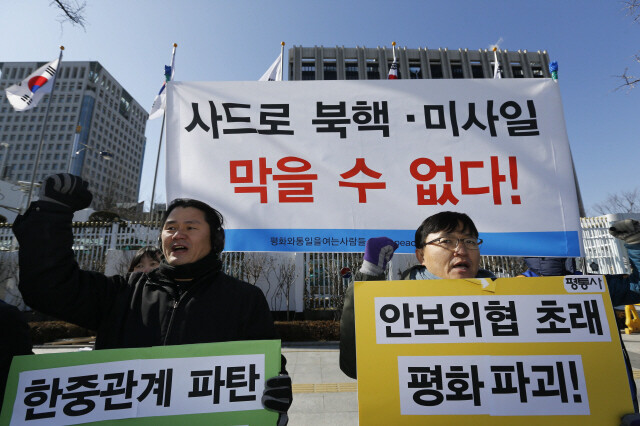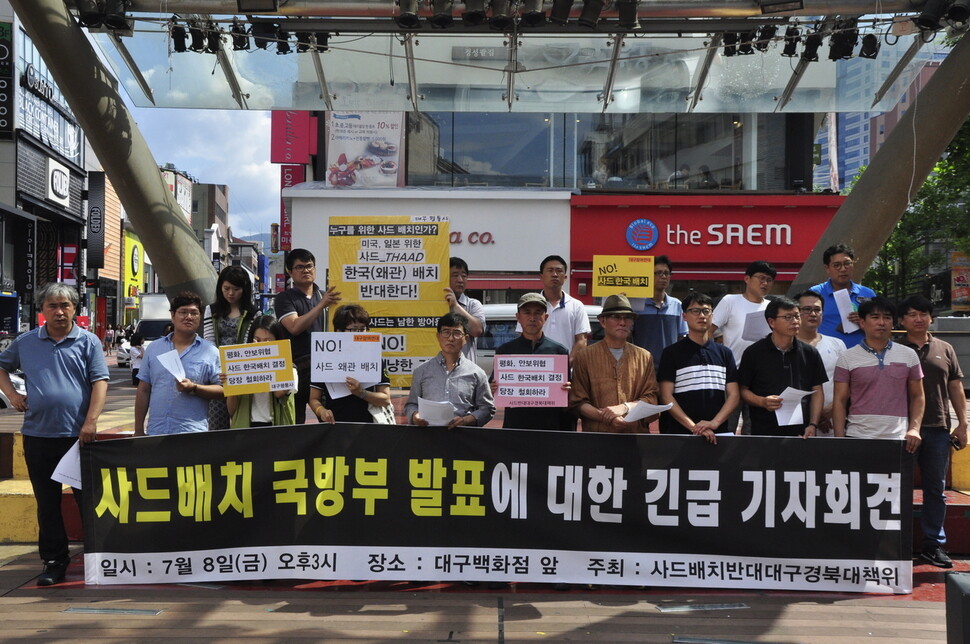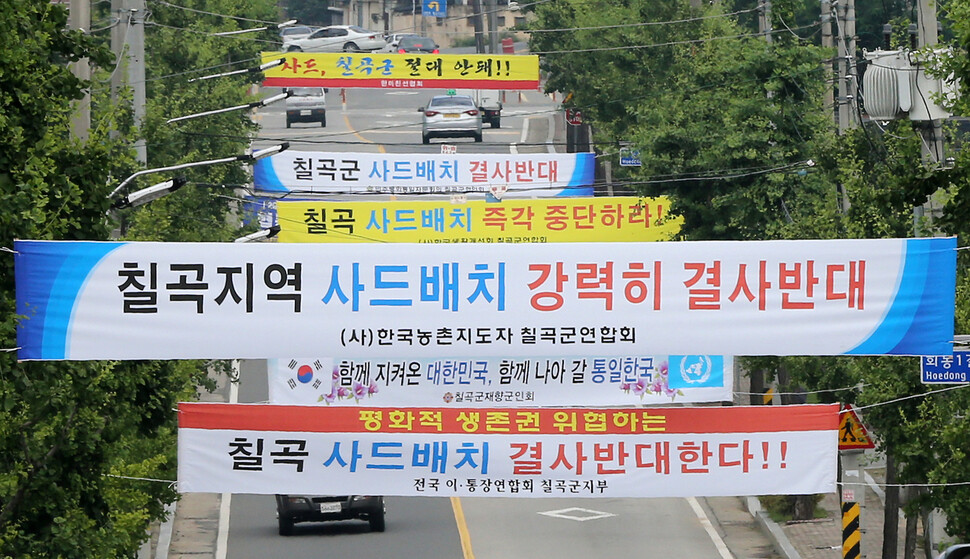hankyoreh
Links to other country sites 다른 나라 사이트 링크
[Editorial] THAAD deployment on the Korean Peninsula opens Pandora's box

South Korea and the United States announced on July 8 that they had decided to deploy the Terminal High-Altitude Area Defense (THAAD) missile defense system with United States Forces Korea (USFK). This constitutes a series of strong-arm tactics, as the announcement came only a day after the US government imposed sanctions on Kim Jong-un personally for human rights abuses. Though the blacklisting of Kim Jong-un is directed only at North Korea, the THAAD deployment is a broader measure that threatens to generate political and military discord and destabilize the balance of security throughout Northeast Asia, including China and Russia. This puts inter-Korean dialogue and negotiations on the back burner, bringing on a dangerously stressful state of affairs that we can expect to last for some time.

In a joint statement during a press conference called by the South Korean Ministry of National Defense, the South Korean side and the US government explained the background of the deployment, saying, "South Korea and the United States made an alliance decision to deploy THAAD to USFK as a defensive measure to ensure the security of the South and its people, and to protect alliance military forces from North Korea's weapons of mass destruction and ballistic missile threats."
Aware of China's and Russia's opposition, they emphasized that "When the THAAD system is deployed to the Korean Peninsula, it will be focused solely on North Korean nuclear and missile threats and would not be directed towards any third-party nations." It is said that the South Korean government had already explained this point to the Chinese and Russians on the previous day.
This sort of explanation is bound to fall on deaf ears in China and Russia. Numerous times, the two countries have at the highest levels publicly opposed THAAD deployment in South Korea as breaking the strategic balance with the U.S. In response to the South Korea-U.S. joint decision, the Chinese Foreign Ministry took a firm stance, saying it was “strongly dissatisfied and firmly opposed.” The Chinese government summoned Kim Jang-soo, South Korea's ambassador to China, to convey its strong protest against the move.
The Chinese and Russian backlash will have two grave effects on South Korea. It will make it all the more difficult for us to solve the problem of North Korean nuclear development through safe, diplomatic channels and will intensify the new Cold War between South Korea, the U.S., and Japan on one side and North Korea, China, and Russia on the other. In order to resolve the North Korean nuclear issue, which is the biggest threat to our national security, the South Korean government has put a huge effort into getting Chinese cooperation in taming Pyongyang.
Even in the face of concerns expressed by the United States and Japan, President Park Geun-hye attended a military parade in Beijing last year. The THAAD deployment makes all of that moot. Furthermore, it means that South Korea is getting in deeper with the Japan-U.S. blockade of China and ballistic missile defense. South Korea is an outpost for observing and restraining military developments in China and Russia, which makes our country the focus of conflict and confrontation between the South, the U.S., and Japan versus the North, China, and Russia. Though aimed at checking provocations by North Korea, the THAAD system actually has the opposite effect of destabilizing security on the Korean Peninsula.
Another issue is the strong possibility that the Chinese and Russian opposition will cast a dark cloud over our economy. It appears that China's stance may negatively influence trade and tourism. This is an issue of grave concern, considering the South Korean economy's tremendous level of dependence on China. Stock markets are highly susceptible to such problems, and stocks related to China are already falling drastically.
Ignoring other factors and just looking at the military aspect, we admit that THAAD can in fact help restrain missile provocation by North Korea, but this is like trying to secure your position in a game of Go by floundering around in only one corner of the board instead of taking in the entire layout. Even on American soil, THAAD has been deployed in Guam only, and its performance has not yet been fully verified. It is also very expensive, costing between 1.5 and 2 trillion Korean won (US$1.3 to $1.7 billion) per installation. Experts point out that in view of the short distance between the North and the South, it would be difficult to intercept North Korean missiles with THAAD.

From the time when General Curtis Scaparotti, then commander of the USFK, first brought up THAAD deployment right up until North Korea conducted its fourth nuclear test on January 6, the Park administration denied that it had requested, discussed, or decided anything in regard to THAAD, but then, on January 13, in her New Year's press conference, the president unexpectedly stated that the government had decided to deploy the system.
Perhaps the administration's continuous denial of having had consultations with the U.S. on THAAD was intended as a means of hiding them from its neighboring countries and from its own people. Otherwise, this was just a sudden about-face made immediately after the fourth North Korean nuclear test, which makes the decision seem all too desultory. Whichever the case, this cannot be seen as a position that a responsible government would take.
An urgent domestic concern in light of the decision is exactly where in the country THAAD is to be deployed. The military has stated that they will announce the selected locations in a matter of weeks and will be ready to put the installations in operation by the end of next year. In candidate locations, such as Chilgok, North Gyeongsang Province, local residents and leaders are already expressing opposition, showing strong resistance.
As the person who made the decision for deployment, President Park is ultimately responsible for whatever aftereffects it will have, both domestically and internationally.

Please direct questions or comments to [english@hani.co.kr]

Editorial・opinion
![[Column] Season 2 of special prosecutor probe may be coming to Korea soon [Column] Season 2 of special prosecutor probe may be coming to Korea soon](https://flexible.img.hani.co.kr/flexible/normal/500/300/imgdb/original/2024/0426/3317141030699447.jpg) [Column] Season 2 of special prosecutor probe may be coming to Korea soon
[Column] Season 2 of special prosecutor probe may be coming to Korea soon![[Column] Park Geun-hye déjà vu in Yoon Suk-yeol [Column] Park Geun-hye déjà vu in Yoon Suk-yeol](https://flexible.img.hani.co.kr/flexible/normal/500/300/imgdb/original/2024/0424/651713945113788.jpg) [Column] Park Geun-hye déjà vu in Yoon Suk-yeol
[Column] Park Geun-hye déjà vu in Yoon Suk-yeol- [Editorial] New weight of N. Korea’s nuclear threats makes dialogue all the more urgent
- [Guest essay] The real reason Korea’s new right wants to dub Rhee a founding father
- [Column] ‘Choson’: Is it time we start referring to N. Korea in its own terms?
- [Editorial] Japan’s rewriting of history with Korea has gone too far
- [Column] The president’s questionable capacity for dialogue
- [Column] Are chaebol firms just pizza pies for families to divvy up as they please?
- [Column] Has Korea, too, crossed the Rubicon on China?
- [Correspondent’s column] In Japan’s alliance with US, echoes of its past alliances with UK
Most viewed articles
- 1‘We must say no’: Seoul defense chief on Korean, USFK involvement in hypothetical Taiwan crisis
- 2Is Japan about to snatch control of Line messenger from Korea’s Naver?
- 3Division commander ordered troops to enter raging flood waters before Marine died, survivor says
- 4S. Korea “monitoring developments” after report of secret Chinese police station in Seoul
- 5The dream K-drama boyfriend stealing hearts and screens in Japan
- 6[Column] Season 2 of special prosecutor probe may be coming to Korea soon
- 7[Editorial] Korea’s surprise Q1 growth requires objective assessment, not blind fanfare
- 8No good, very bad game for Korea puts it out of Olympics for first time since 1988
- 9[Column] ‘Choson’: Is it time we start referring to N. Korea in its own terms?
- 10Is N. Korea threatening to test nukes in response to possible new US-led sanctions body?